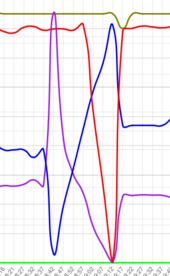fourtytwo
New Member
Hello I have a ~1Kw inverter with two ~1Kw PV strings in parallel pointing in slightly different directions.
As expected MPPT handled the combination with no problem even though there was a voltage difference.
However what I was not expecting is that when up against the inverter power limit in full sun MPPT finds many different voltage/current combinations to provide 1Kw and unfortunately was tending to lean towards lower voltages and higher currents. e.g. 120V@8.3A =1Kw but so does 80V@12.5A increasing ohmic losses and reducing efficiency.
What I chose to do was to implement thermal current limiting by averaging input current over a minute and forcing mppt to increase voltage a step if the limit were exceed (increasing voltage will reduce current) until such time as the average current subsides.
Another tactic was to reverse the direction of the periodic voltage scan that hunts for the true peak power, it used to scan from the highest to the lowest voltage and hence report the peak with the lowest voltage, having discovered this is sub-optimal it now scans from the lowest to the highest voltage reporting the highest voltage that produces peak power. When the inverter is over paneled in this way the peak power corresponds to the maximum inverter power and under full sun is a plateau rather than a peak.
In the plot blue is volts, violet is amps & red is watts (ignore gold & green). This clearly shows the plateau as watts are maintained at maximum for a wide range of voltages.

As expected MPPT handled the combination with no problem even though there was a voltage difference.
However what I was not expecting is that when up against the inverter power limit in full sun MPPT finds many different voltage/current combinations to provide 1Kw and unfortunately was tending to lean towards lower voltages and higher currents. e.g. 120V@8.3A =1Kw but so does 80V@12.5A increasing ohmic losses and reducing efficiency.
What I chose to do was to implement thermal current limiting by averaging input current over a minute and forcing mppt to increase voltage a step if the limit were exceed (increasing voltage will reduce current) until such time as the average current subsides.
Another tactic was to reverse the direction of the periodic voltage scan that hunts for the true peak power, it used to scan from the highest to the lowest voltage and hence report the peak with the lowest voltage, having discovered this is sub-optimal it now scans from the lowest to the highest voltage reporting the highest voltage that produces peak power. When the inverter is over paneled in this way the peak power corresponds to the maximum inverter power and under full sun is a plateau rather than a peak.
In the plot blue is volts, violet is amps & red is watts (ignore gold & green). This clearly shows the plateau as watts are maintained at maximum for a wide range of voltages.




